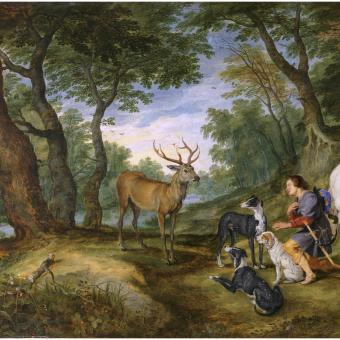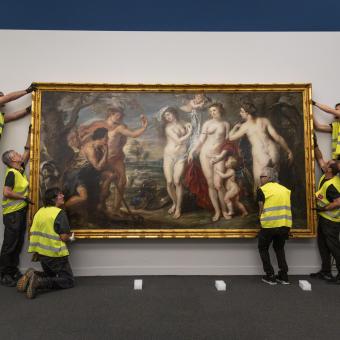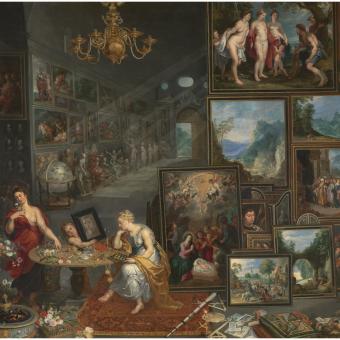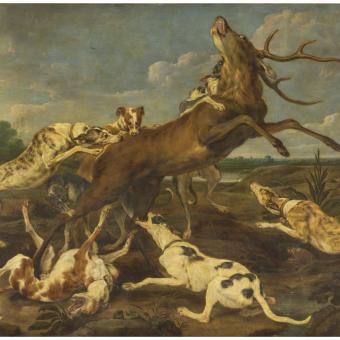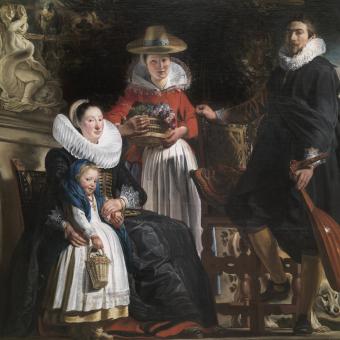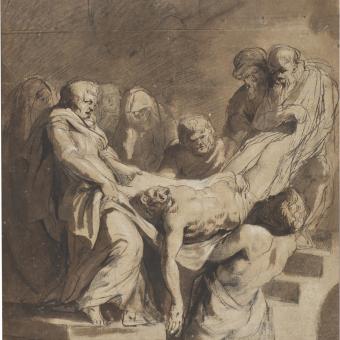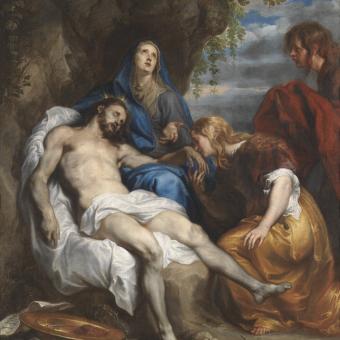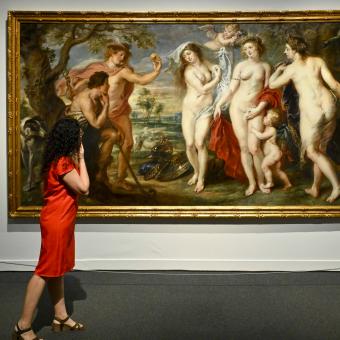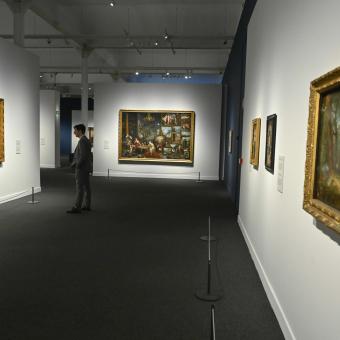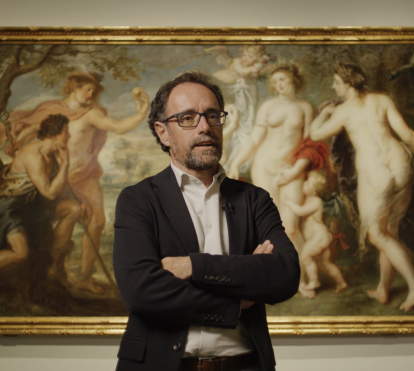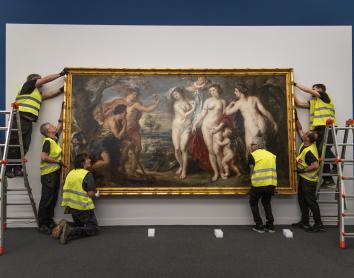
CaixaForum Barcelona inaugurates the exhibition Rubens and the Flemish Baroque Artists, featuring 62 works from the collections of the Museo Nacional del Prado. The exhibition showcases the creative force of the foremost exponent of the Flemish Baroque in dialogue with other prominent artists of his time, such as Van Dyck, Jordaens and Brueghel. Structured into nine thematic areas, the exhibition features a parallel universe of activities to enrich the offering.
The director of CaixaForum Barcelona, Mireia Domingo; the director of the Museo Nacional del Prado, Miguel Falomir; and the curator of the exhibition and conservator at the Flemish Painting and Northern Schools Conservation Area of the Museo Nacional del Prado, José Juan Pérez Preciado, have this Wednesday presented the unprecedented exhibition Rubens and the Flemish Baroque Artists. Collections of the Museo del Prado.
This is the sixth exhibition jointly organised by the ”la Caixa” Foundation and the Museo Nacional del Prado to be held at CaixaForum Barcelona, following Goya: Lights and Shadows (2012); Captive Beauty: Small Treasures from the Prado Museum (2014); Velázquez and the Golden Age (2018–2019); Art and Myth: The Gods of the Prado (2018–2023); and The Nineteenth Century: The Age of Portraiture. The Prado Museum Collections. From the Enlightenment to Modernity (2023–2024). Both institutions have maintained a strategic alliance since 2011 to bring part of the rich artistic heritage safeguarded by the Museo Nacional del Prado closer to the public.

The exhibition, which can be visited until 21 September at CaixaForum Barcelona, features a sober and elegant staging, and is divided into an introduction and nine thematic, non-chronological sections:
- Introduction
- Impassioned
Creation
- Divine
Passions
- Image
and Counter-Reformation
- Patronage
and Collecting
- Art
and Power
- The
Nobility of Painting
- Faces
and Personalities
- Inside
and Outside
- Living
Nature, Still Life
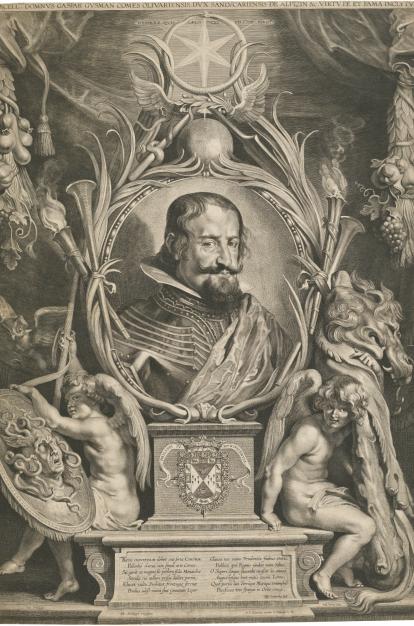
Peter Paul Rubens (1577-1640), regarded as a pivotal figure in art history, was already celebrated in his own time as one of the most powerful artistic creators in history. A central figure with numerous followers, he was instrumental in the development of Flemish Baroque. Rubens transcended his role as an artist; he was a scholar and a profound connoisseur of antiquity, especially Stoic philosophy. He was also an eloquent speaker and a polyglot, qualities that opened the doors of European royal courts to him, leading to invitations from various courts throughout his life.
Artistically, Rubens is renowned for his impassioned compositions, characterised by an almost violent dynamism and a profoundly sensual expressiveness – hallmarks that became fundamental to Baroque aesthetics. His immense output and compelling personality propelled the renewal of artistic creation in 17th-century Flanders. Inspired by his spirit, various local artists either followed in Rubens’ creative footsteps or developed parallel artistic identities, as reflected in this exhibition. Thus, Flemish Baroque represents one of the most evocative and visually captivating periods in Western culture.
The exhibition underscores these principles through the rich collections of the Museo Nacional del Prado.On display are not only some of the most spectacular paintings by this artist and other prominent painters, such as Anthony van Dyck, Jacob Jordaens, Jan Brueghel the Elderand David Teniers, which typically adorn the museum’s walls, but also an extensive array of prints, drawings, ivories, silver objects and books from its lesser-known holdings, providing a comprehensive view of the excellence achieved by Flemish Baroque creativity.
These works illustrate the intense intellectual and aesthetic weight that marked the output of Rubens and his Flemish contemporaries, which today, 400 years later, continues to captivate and fascinate, both for the spectacular nature of their art and for the subtlety of the ideas they convey.
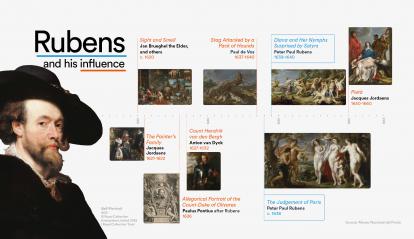
Welcome to Rubens’
workshop
A scenographic recreation of an artist’s workshop –reminiscent of the one overseen by Rubens, complete with easels, ornate chairs, frames and other working materials– welcomes visitors to the exhibition, immersing them in the atmosphere of a Flemish Baroque artistic workspace.
As an introductory feature, visitors will encounter an engraving of Rubens in which he portrays himself as a distinguished nobleman, a piece that has been specially restored for the occasion.
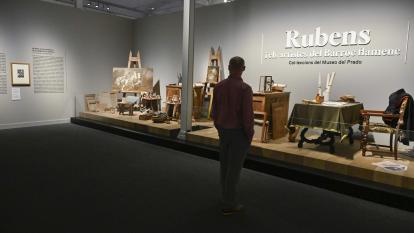
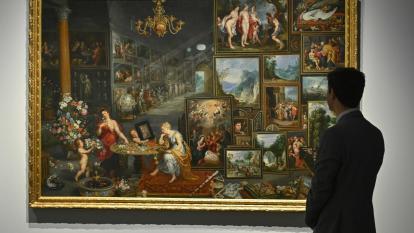

The first section, “Impassioned Creation", showcases Rubens as an extraordinarily multifaceted artist. Painter, scholar, courtier, diplomat and collector, his cosmopolitan nature and extensive cultural knowledge, combined with his profound and vibrant approach to life and art, were exceptionally rare among artists in the Low Countries at that time.
The spectacular nature of Rubens’ pictorial compositions was a reflection of an exalted creative drive that led him to study and copy works by earlier artists, from antiquity, the Renaissance and the local Flemish tradition. He would sometimes modify these works, as if aiming to perfect them, introducing paradigmatic images of a grand artistic past to the north. Moreover, as a great admirer of classical culture, the artist incorporated sculptural pieces from the past into his paintings. Among these, the Mannerist The Last Supper by Maarten van Heemskerck stands out, which Rubens himself retouched with white highlights to impart different tonalities.
He was a remarkable draughtsman who designed tapestries, architectural works, book covers and ephemeral decorations for public ceremonies, always with a scholarly spirit and great imaginative and artistic capacity. His passion for creation led him to collect all kinds of pieces –from paintings and sculptures to books and luxury objects– which he treasured in a spectacular house-studio in Antwerp.
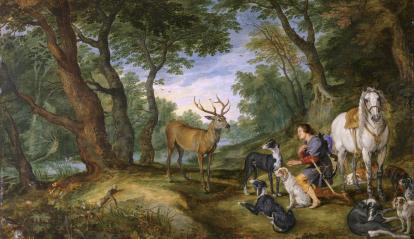
Notably, the painting The Death of Seneca, executed by Rubens and his workshop, depicts the philosopher committing suicide while his disciples take his final notes. The painting, inspired by the face of an ancient sculpture representing a fisherman, demonstrates the artist’s interest in revisiting the past.
During his journey to Italy, Rubens studied the great masters of the Renaissance, such as Raphael, Titian and Leonardo da Vinci. In fact, he also drew The Battle of Anghiari, to which Da Vinci dedicated a fresco in the Palazzo Vecchio in Florence, now lost. Thanks to Rubens’ interest in the past, we can now see that fresco by the Renaissance master.
Visitors can also see some of the numerous covers he made for various publications. An example is the cover of Opera quae extant. Chronicon et adversaria…, which Rubens drew and the engraver Cornelis Galle the Younger completed. It is also possible to see tapestries, as revealed by the sketch in the work that would represent Achilles Discovered among the Daughters of Lycomedes, a sketch that hints at the moral often hidden in his paintings about classical mythology.
Divine passions: classical mythology in Flemish Baroque
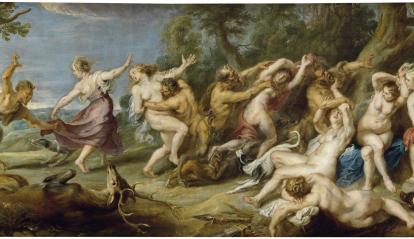
In the second section, “Divine Passions”, the exhibition delves into themes characteristic of Flemish Baroque painting, with a particular emphasis on classical mythology. A highlight of this section is Rubens’ painting The Judgement of Paris, one of the most remarkable and significant works in the exhibition, which has been specially restored for the occasion. In fact, at this link you can read a report on the work's arrival, as well as download images of the unpacking process.

Created in the later period of Rubens’ career, the painting reflects his deep interest in antiquity, classical myths, the study of Ovid’s Metamorphoses and the depiction of sensuality. In this large-scale composition, the Trojan prince Paris is tasked with choosing one of three goddesses, each offering him a different reward: love, wisdom or power. Paris selects Venus, the embodiment of love, thereby setting in motion the events leading to the Trojan War.
Another painting featured in this section is Diana and Her Nymphs Surprised by satyrs, in which Rubens presents one of his favourite themes, with mythological figures enjoying love and nature. Artistically, Rubens demonstrates his study of antiquity and the Renaissance. This work is part of a series of hunting scenes, typical of that historical period.
In The Rape of Europa, a depiction of another episode from Ovid’s Metamorphoses, the artist lays out the foundations of a painting through a sketch, offering insight into how he worked and developed proposals for other artists in his circle. Nearby, there is a life-sized canvas of the same subject by the artist Erasmus Quellinus, executed on the basis of Rubens’ original design.
Also included are works such as the drawing The Birth of Apollo and Diana, which has been exhibited on very few occasions. In keeping with Rubens’ interest in mythology, other artists followed his influence. This can be seen in works such as Apollo Victorious over Pan by Jacques Jordaens, and the exquisitely delicate Dance of Children with the God Pan, carved in ivory by Lucas Faydherbe.
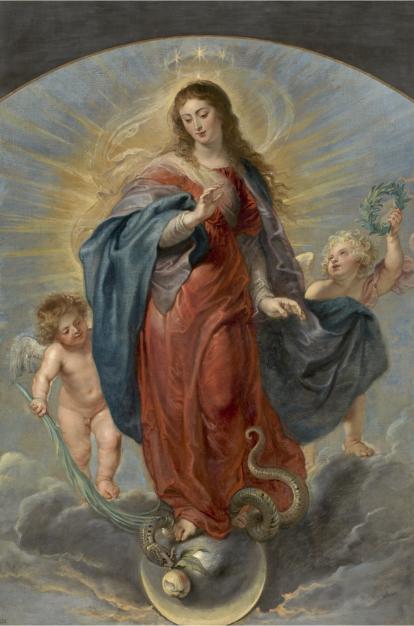
A great innovator of religious iconography
In the third section, “Image and Counter-Reformation”, Rubens is highlighted as a key figure in the renewal of religious iconography. As a result of the religious wars in the latter half of the 16th century, much of the religious heritage in the Low Countries was destroyed by Protestant iconoclasts, leaving many church interiors empty.
This situation, combined with the renewed propagandistic impetus of the Catholic Counter-Reformation, presented a unique opportunity for Rubens and the new generation of Flemish artists. Rubens channelled his creative force into serving the new religious ideals through images imbued with tension, emotion, violence and faith. These were manifested in monumental altarpieces for churches and cathedrals, as well as in smaller paintings intended for private oratories, such as his Rest on the Flight into Egypt with Saints, which once belonged to Charles I of England.
Other notable works in this section include Pietà by Anthony van Dyck, painted with a more sensual, appealing and less violent approach than that of Rubens. Nearby is the Pietà by Jordaens, whose depiction of the lifeless arm recalls the iconic The Descent from the Cross by Rogier van der Weyden, which can be seen at the Prado Museum.
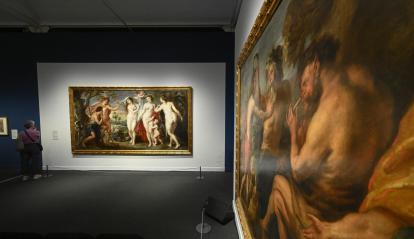
In Jordaens’ The Entombment of Christ, visitors can observe how the artist employed ink drawing techniques, in contrast to the painting technique used in his Pietà.
In reference to grand altarpieces, The Massacre of the Innocents is displayed – an engraving by Paulus Pontius based on a large altarpiece by Rubens, usually housed in Munich and notable for its intensity and visual violence. In contrast, another drawing, The Mystical Vision of Hermann-Joseph, by the same artist, reproduces a painting by Van Dyck with a more devotional yet equally captivating aesthetic.
This section culminates with The Birth of the Virgin by Erasmus Quellinus, characterised by a more classicist style, featuring references to architectural elements from antiquity, such as a Greek pediment, alongside Baroque Solomonic columns.
The birth of collecting during the Baroque period
The fourth section, “Patronage and Collecting”, examines how the culture of collecting emerged in Flanders during the Baroque period. The rich artistic production of Flemish Baroque art was greatly supported by a group of art lovers who supported artists and took pleasure in amassing their creations.
Isabel Clara Eugenia, daughter of Philip II and governor of the Low Countries, recognised the potential of Flemish art to proclaim the prosperity of the territories under her rule. Rubens’ brushes joined the Isabelline cause alongside that of another of her protégés, Jan Brueghel the Elder, who specialised in landscapes and still life themes. Their collaboration resulted in works where visual beauty and delicacy were as significant as the message of cultural excellence they sought to convey – paintings that were often sent to the Spanish court.
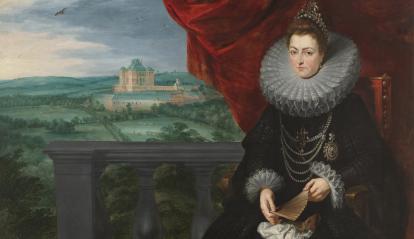
This section includes the painting The Infanta Isabel Clara Eugenia, by Rubens and Jan Brueghel the Elder, considered one of the most prominent artists of the period. She governed during Rubens’ artistic career and became a great patron of the artist.
A remarkable oil painting by Jan Brueghel the Elder and Giulio Cesare Procaccini, Garland with the Virgin and Child and Two Angels, is also on display. This collaborative work was likely commissioned by Federico Borromeo, Cardinal Archbishop of Milan, a scholar of art and patron to both artists. Depictions of the Virgin surrounded by flowers became prominent among Flemish artists in the early 17th century as a response to the Protestant Reformation, which rejected the representation of devotional images.
Another outstanding painting is the large-format canvas Sight and Smell, created by Jan Brueghel the Elder, Hendrick van Balen, Frans Francken II and others. This work exemplifies the emergence and rise of collecting culture in the Low Countries during that period. Along with its companion piece, Taste, Hearing and Touch, these paintings are replicas of two lost originals that the City of Antwerp gifted to Archdukes Albert and Isabella Clara Eugenia to showcase the wealth, exuberance and progress of the Flemish region.

The painting The Vision of Saint Hubert, by Rubens and Jan Brueghel the Elder, depicts a distinctly Flemish theme through the story of Saint Hubert, the patron saint of the Low Countries. According to legend, Hubert led a dissolute life until he experienced a divine epiphany: while about to hunt a stag, he saw a crucifix appear between its antlers. This vision led to his conversion to Christianity. The artwork was once owned by the Marquis of Leganés, a prominent admirer of Flemish painting at the court of Philip IV.
Also featured in this section is the painting Vase of Flowers, which showcases the exceptional artistic skill achieved by Brueghel the Elder, rendered with near-botanical precision. The vase depicted by the painter is of Chinese origin, highlighting Antwerp’s commercial significance during that era.
Religious
and political propaganda
The fifth section, “Art and Power”, highlights how Flemish art became an excellent tool for political communication. In a Spain immersed in continuous wars against the Protestant world, its dissemination was often linked to religious propaganda, to which Rubens dedicated his artistic creations.
Given his diplomatic skills and courtly manners, Rubens painted portraits of rulers throughout Europe, which frequently influenced local artists. He also created allegorical compositions tailored to the powerful, combining formidable visual strength with highly effective propagandistic messages.
In addition to Rubens, other painters, engravers, poets and scholars who were also in the service of the same powers created artistic works that celebrated the military and political glories of European princes. The origin of the pieces presented here is, for the most part, the Spanish Royal Collection, the seed of the Museo del Prado, since they were created to extol the glories of Spain during the reign of Philip IV.
The most outstanding work in this section is The Immaculate Conception by Rubens, whose devotion became a matter of state for Spain and was painted on a single occasion by the Flemish artist. The work was gifted to the Marquis of Leganés, one of his greatest admirers and his major patron at the Madrid court, in the same year that Rubens’ acceptance as a diplomat in the service of Philip IV was being debated in Spain. The Marquis of Leganés presented it to the king. The dogma of the Immaculate Conception was not approved until the 19th century, but in the 17th century it was a subject of great importance.
For the Allegorical Portrait of the Count-Duke of Olivares, Rubens used Velázquez’s portrait of Philip IV’s favourite as a model to design a political allegory that exalted his figure as a ruler, later engraved by Paulus Pontius.
Battles became another recurring theme for propagandistic purposes. This is the case with Isabel Clara Eugenia at the Siege of Breda, by Peter Snayers, a work in which the artist depicts the Spanish siege of Breda, which lasted almost a year between 1624 and 1625. In the foreground, the governor Isabel Clara Eugenia appears alongside General Ambrosio de Spínola on the battlefield after the victory.
This work by Snayers, a great specialist in the pictorial representation of battles, is displayed near Jacques Callot’s etching The Siege of Breda, in which he depicted the details of the siege of Breda in six meticulous prints that, when joined together, could be hung in the manner of Snayers’ paintings.
The
cultivation of portraiture and studies of the human figure
The cultivation of portraiture and studies of the human figure from live models, which were then used in the characters in paintings, were common practices among Flemish Baroque artists. Their skill in depicting physical details was matched by a clear desire to capture the sitter’s personality and to project highly individualised images with evident propagandistic overtones.
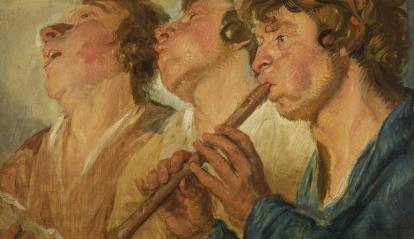
However, the means to achieve this varied and were always highly personal, encompassing all mediums and techniques, from oil portraits to drawings and engravings. Each artist employed diverse techniques and compositions, from Rubens’ loose brushwork to the more stereotyped approach of artists from another generation, such as Frans Pourbus the Younger; from the vehement scenes of Van Dyck to more classical ones, like those of Jordaens, who nonetheless used a very loose technique in his studies of heads.
The sixth section, “Faces and Personalities”, focuses on this theme and includes a notable portrait of Marie de’ Medici, Queen of France, by Rubens himself, in which the strong personality and political power of the sitter are evident. Rubens began this unfinished portrait while painting the Marie de’ Medici cycle for her Luxembourg Palace in Paris.
Nearby, visitors can also see another portrait of Marie de’ Medici by the artist Frans Pourbus the Younger, who belonged to a family of portraitists from Bruges who settled in Antwerp, where he worked for the governors. His portraits, such as this one of the Queen Mother of France, denote a strict severity in the presentation of the sitter, with figures in emotionless and markedly distant poses, following a more traditional trend distinct from Rubens’ approach.
Anthony van Dyck was the preeminent portraitist among Flemish artists. His powerful portrait of Count Hendrik van den Bergh can be seen here. Alongside this painting is an engraving by Paulus Pontius, based on Van Dyck’s portrait, an artist who greatly influenced 18th-century English portrait painters.
In this section, attention is drawn to Jacob Jordaens’ work Three Itinerant Musicians, which exemplifies his relentless pursuit of expressiveness. Through loose brushstrokes, Jordaens endeavours to capture the physical essence of music.
The
nobility of being a painter in that era
In the seventh section, “The Nobility of Painting”, the focus is on the self-representation of artists as distinguished figures. The concept of the ennobled artist, working for a prince and already a prominent member of society, is a common theme in Flemish art, which later painters such as Van Dyck and Rubens would incorporate into their portraits.
At the same time, the assertion of the art of painting as a noble pursuit, which indirectly conferred aristocracy upon its practitioners, is a theme already explored by Nordic artists before Rubens became its finest example. This is exemplified by certain allegorical engravings from the early 16th century, in which the practice and status of art and painting are presented as a superior intellectual activity.
In this space, the painting The Painter’s Family by Jacob Jordaens stands out, in which the artist portrays himself alongside his family as a bourgeois who enjoys music, accompanied by a maid bringing them fruit. Also notable is an engraving of Jan Brueghel by Van Dyck, who created a series of engravings of prominent men associated with the Low Countries known as The Iconography, which was widely disseminated at the time and included princes, aristocrats, politicians, military figures and artists.
Additionally, the space features a satirical painting on creation with the canvas The Monkey Painter, by David Teniers, in which a monkey with painter’s attributes recreates an idea on a canvas in his workshop; the future client, exuding grandeur, adorned with feathers, a gold chain and a pouch at his waist, attentively observes his skill.
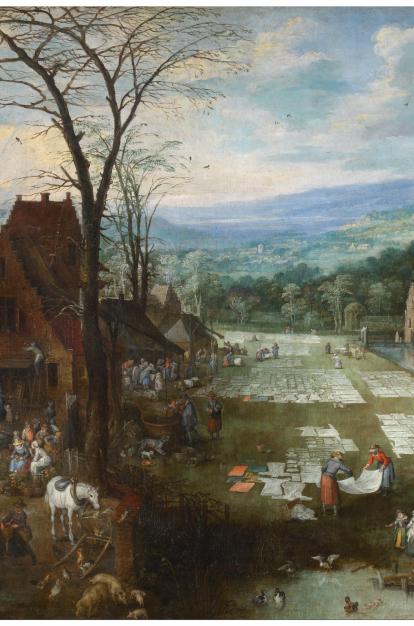
The
significant impact of pictorial genres on Flemish painting
The eighth section, “Inside and Outside”, explores the representation ofthe Flemish landscape as a genre and as a reflection of daily life in the Low Countries through various works, such as Market and Washing Place in Flanders by Jan Brueghel the Elder and Joos de Momper II, one of the leading specialists in this genre at the time.
Everyday life was a very common subject for artists in the Low Countries from the late 16th century onwards. Depictions of peasant customs, traditional festivities and even proverbs and popular sayings became common themes in art, giving rise to what are known as genre scenes. Thanks to these representations, we know what the fields, people and Flemish cities looked like. These are recreations of the famous kermesses, indoor and outdoor scenes that were also highly appreciated by collectors.
Certain artists dedicated themselves to this type of representation. The works of David Teniers became a paradigm of Flemish culture and popular life, of the enjoyment of everyday life, which was sometimes shared by the aristocracy. The exhibition features paintings such as Villagers’ Lunch, created in collaboration with the landscape painter Lucas van Uden; the exquisite drawing Village Festival, not previously exhibited; and the interior painting The Smokers, all of them significant pieces by the artist.
Finally, in the section “Living Nature, Still Life”, the exhibition explores kitchen scenes and still lifes popularised by certain Flemish Baroque painters, especially Frans Snyders, as a continuation of a genre that held significant prominence in the Low Countries at the end of the 16th century.
Particularly noteworthy is the painting Stag Attacked by a Pack of Hounds, by Paul de Vos, which depicts the unbridled violence of the hunt in a pictorial exercise that captures the anatomy of the animals, as well as other more challenging elements to portray, such as movement, agility and even ferocity, through a carefully composed arrangement filled with diagonals and foreshortenings.
Also noteworthy is the canvas The Fruit Bowl by Frans Snyders, where viewers can appreciate his remarkable ability to reproduce the tactile quality of fruit, objects and animals. This artist was highly esteemed during his time.
Additionally, the work Concert of Birds by Jan Fyt stands out. This painter possessed an exquisite skill in capturing the various textures of animals. The theme of the “concert of birds", of medieval origin, became fashionable among a group of Flemish artists led by Frans Snyders in the early decades of the 17th century.
Animal paintings became a speciality of Antwerp that, over the years, would be imitated in France and elsewhere. The growing interest in the study of animal behaviour and anatomy gave great impetus to its establishment as an autonomous pictorial genre. Its success was also due in part to the use of ancient fables as metaphors for human behaviour, as well as the development of hunting, an activity reserved for the elite.
These types of paintings became luxury items, reflecting the tastes and hobbies of the wealthy classes, who were eager to collect and display such works in their homes not only for their visual beauty but also for their modernity. It is a genre that would enjoy a long trajectory as a collectible. This is also reflected in other works included in this final section, such as Still Life with a Dog and a Cat, by Christiaan Luycks, initially attributed to Jan Fyt.
Visitors:
collaborators of Rubens for a day
Midway through the exhibition, specifically between the seventh and eighth rooms, visitors can discover an educational audiovisual presentation that shows Rubens’ creative process and his workshop in detail, highlighting the layers and brushstrokes of various collaborators. The copy featured in the video, which is also on display, is of Rubens’ Mercury and Argus.
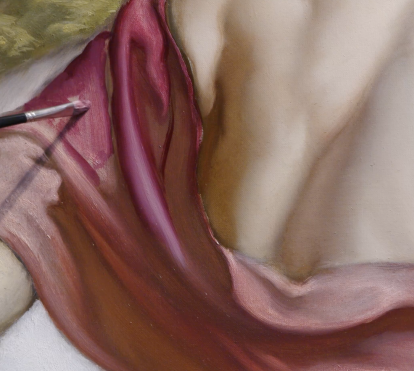
Subsequently, the exhibition presents a mediation space entitled “From the workshop to the gallery”, referencing the emergence of collecting during that era. Visitors can move through two visually distinct areas: the workshop and the gallery. In both, they are invited to complete a commission from the master of the workshop with an educational objective through interaction.
Visitors will be able to choose from various silhouettes of figures taken from different paintings featured in the exhibition and place them onto backgrounds of artworks. They will have access to instructions and books that also provide information about who these figures are, as well as the origin of the proposed backgrounds.





